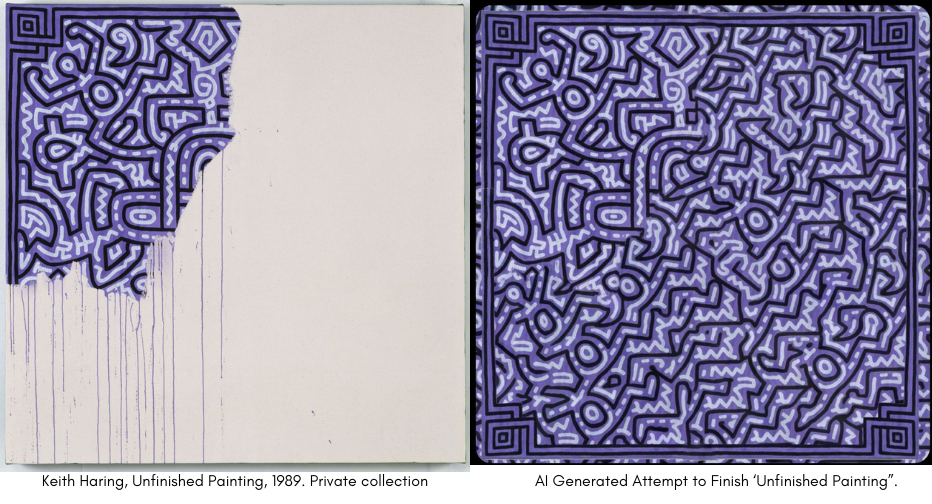AI “Completes” Keith Haring’s Unfinished Painting and Controversy Erupts

The story behind this painting is so sad! 😢
Now using AI we can complete what he couldn’t finish! ❤️ https://t.co/RuASoTfFdk pic.twitter.com/uAwM6SBUGW— Donnel (@DonnelVillager) December 31, 2023
The celebrity graffiti artist Keith Haring died in 1990, at the age of 31, no doubt having completed only a fraction of the artwork he would have produced in a life a few decades longer. Upon first seeing his Unfinished Painting of 1989, one might assume that his early death is what stopped him from finishing it. In fact, painting only about a quarter of the canvas was his deliberate choice, intended to make a visual commentary on the AIDS epidemic that had claimed so many lives, and, not long thereafter, would claim his own. Presumably, it never occurred to anyone to “finish” Unfinished Painting — not before the age of artificial intelligence, anyway.
“Last summer, artist Brooke Peachley … posted a photo of the work on X” — the social media platform formerly known as Twitter — “alongside a prompt asking others to respond with a visual art piece ‘that never fails to destroy [them] every time they see it,’ ” write Elaine Velie and Rhea Nayyar at Hyperallergic. “Over six months later, another user responded to the original post with a generative AI image that ‘completed’ Haring’s purposely half-painted work, writing, ‘now using AI we can complete what he couldn’t finish!’ ”
One might, perhaps, sense a joking tone in that post, though the many incensed commenters it continues to draw seem not to take it that way. “The post swiftly caught the ire of the X community, with users describing the action as ‘disrespectful,’ ‘disgusting,’ and a ‘desecration,’ ” says Artnet News. “Some praised the powers of A.I. for ‘showing us a world without AIDS,’ while others deemed the tweet excellent ‘bait’ on an Elon Musk-led online platform that newly rewards outrage with engagement.” As often these days — and very often when it comes to applications of artificial intelligence in popular culture — the reactions to the thing are more compelling than the thing itself.
“The A.I.-generated image doesn’t appear to be faithful to Haring’s style, which often included images of human figures,” writes Julia Binswanger at Smithsonian.com. “These kinds of figures are visible in Haring’s original piece, but the image generator wasn’t able to replicate them.” The algorithmically filled-in Unfinished Painting may be without aesthetic or intellectual interest in itself, but consider how many viewers have only learned of the original work because of it. Nevertheless, stunts like this (or like zooming out the Mona Lisa) ultimately amount to distractions from whatever artistic potential these technologies may actually hold. A.I. will come into its own not by generating images that Haring or any other artist could have created, but images that no human being has yet imagined.
Related content:
Demystifying the Activist Graffiti Art of Keith Haring: A Video Essay
A Short Biography of Keith Haring Told with Comic Book Illustrations & Music
Keith Haring’s Eclectic Journal Entries Go Online
Based in Seoul, Colin Marshall writes and broadcasts on cities, language, and culture. His projects include the Substack newsletter Books on Cities, the book The Stateless City: a Walk through 21st-Century Los Angeles and the video series The City in Cinema. Follow him on Twitter at @colinmarshall or on Facebook.


